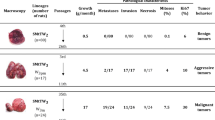Summary
There is general agreement that postoperative radiation therapy is beneficial for patients with subtotally resected pituitary adenomas. We have identified 41 such patients treated during a 20-year period who received postoperative irradiation for a pituitary adenoma. The usual dose was 5040 cGy in 28 fractions. The mean follow-up time was 10.3 years. On routine hematoxylin and eosin (H&E) staining, there were thirty-three chromophobe, seven eosinophilic, and one basophilic adenoma. Tissue blocks were stained for growth hormone (GH), luteinizing hormone (LH), thyroid-stimulating hormone (TSH), prolactin (PRL), and/or adrenocorticotropin ACTH) using the peroxidase-antiperoxidase immunohistochemistry (IHC) method. Routine H&E staining was a poor predictor of the IHC stain. While most patients with a known clinical endocrine syndrome stained positive on IHC for the suspected offending hormone, many patients without a clinical syndrome also stained positive indicating the presence of hormonally occult adenomas in this locally invasive group. The IHC stain results were compared to clinical outcome. The presence of positive GH IHC staining decreased the 15-year progression-free survival (PFS) from 100% to 64% compared to GH negative adenomas (p=0.06). There was a trend toward decreased 15-year PFS in patients who did not stain for LH. Positive staining for prolactin, ACTH, or TSH had no influence on the progression-free survival. We conclude that additional prognostic information can be obtained in this subset of patients (by performing IHC analysis) that is not known by the clinical presentation or appearance on H&E stain.
Similar content being viewed by others
References
Sternberger LA, Hardy PH Jr, Cuculis JJ, Meyer HG: The unlabeled antibody enzyme method of immunohistochemistry. Preparation and properties of soluble antigen-antibody complex (horseradish peroxidase-antihorseradish peroxidase) and its use in identification of spirochetes. J Histochem Cytochem 18: 315–333, 1970
Dixon WJ: BMDP statistical software. University of California Press, Los Angeles, 1983
Kaplan E, Meier P: Nonparametric estimation from incomplete observations. Am Stat Assoc J 53: 457–481, 1958
Mantel N: Evaluation of survival data and two new rank order statistics arising in its consideration. Cancer Chemo Rep 50: 163–170, 1966
Pistenma DA, Goffinet DR, Bagshaw MA, Hanberry JW, Eltringham JR: Treatment of chromophobe adenomas with megavoltage irradiation. Cancer 35: 1574–1582, 1975
Sheline GE: Treatment of nonfunctioning chromophobe adenomas of the pituitary. Am J Roentgenol 120: 553–561, 1974
Sheline GE, Wara WM: Radiation therapy of acromegaly and nonsecretory chromophobe adenomas of the pituitary. In: Syed HG (ed) Tumors of the Nervous System, John Wiley, New York 117–131, 1975
Grigsby PW, Simpson JR, Emami BN, Fineberg BB, Schwartz HG: Prognostic factors and results of surgery and postoperative irradiation in the management of pituitary adenomas. Int J Radiat Oncol Biol Phys 16: 1411–1417, 1989
Kovacs K, Horvath E: Pathology of growth hormone producing tumors of the human pituitary. Sem Diag Path 3: 18–33, 1986
Horvath E, Kovacs K: Gonadotroph adenomas of the human pituitary; sex-related fine-structured dichotomy. A histologic, immunocytochemical and electron microscopic study of 30 tumors. Am J Pathol 117: 429–440, 1984
Mukai K: Pituitary adenomas. Immunocytochemical study of 150 tumors with clinicopathologic correlation. Cancer 52: 648–653, 1983
Scheithauer BW, Horvath E, Kovacs K, Laws ER, Randall RV, Ryan N: Plurihormonal pituitary adonomas. Sem Diag Path 3: 69–82, 1986
Horvath E, Kovacs K, Singer Wet al.: Acidophil stem cell adenoma of the human pituitary. Clinicopathologic analysis of 15 cases. Cancer 47: 761–771, 1981
Robert F, Hardy J: Human corticotroph cell adenomas. Sem Diag Path 3: 34–41, 1986
Author information
Authors and Affiliations
Additional information
Supported by the American Cancer Society Clinical Oncology Career Development Award.
Rights and permissions
About this article
Cite this article
Kovalic, J.J., Mazoujian, G., McKeel, D.W. et al. Immunohistochemistry as a predictor of clinical outcome in patients given postoperative radiation for subtotally resected pituitary adenomas. J Neuro-Oncol 16, 227–232 (1993). https://doi.org/10.1007/BF01057038
Issue Date:
DOI: https://doi.org/10.1007/BF01057038




